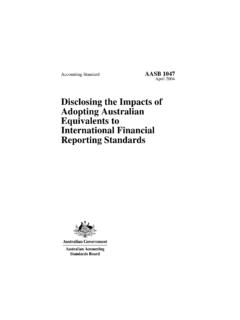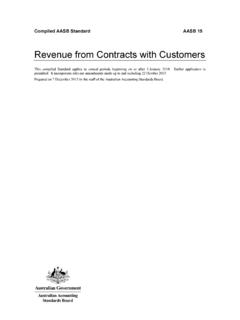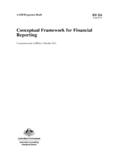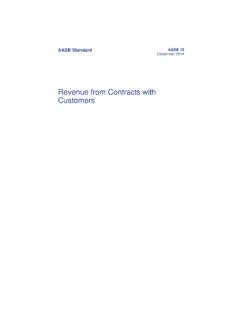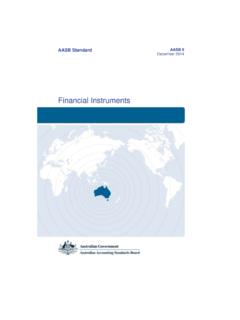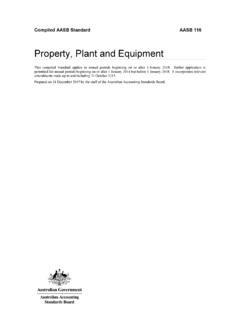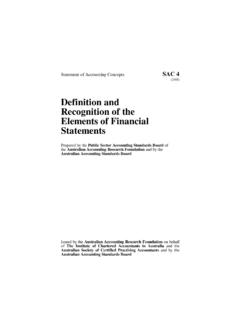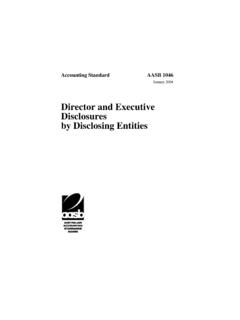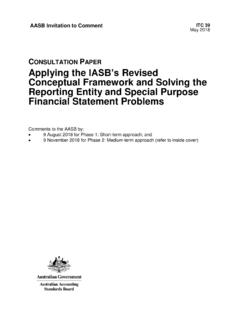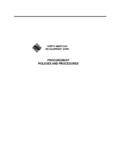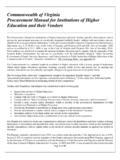Transcription of Share-based Payment - Australian Accounting …
1 AASB Standard AASB 2 July 2015 Share-based Payment Federal Register of Legislative Instruments F2015L01603 AASB 2 2 COPYRIGHT Obtaining a copy of this Accounting Standard This Standard is available on the AASB website: Australian Accounting Standards Board PO Box 204 Collins Street West Victoria 8007 AUSTRALIA Phone: (03) 9617 7637 E-mail: Website: other enquiries Phone: (03) 9617 7600 E-mail: COPYRIGHT Commonwealth of Australia 2015 This AASB Standard contains IFRS Foundation copyright material. Reproduction within Australia in unaltered form (retaining this notice) is permitted for personal and non-commercial use subject to the inclusion of an acknowledgment of the source.
2 Requests and enquiries concerning reproduction and rights for commercial purposes within Australia should be addressed to The Director of Finance and Administration, Australian Accounting Standards Board, PO Box 204, Collins Street West, Victoria 8007. All existing rights in this material are reserved outside Australia. Reproduction outside Australia in unaltered form (retaining this notice) is permitted for personal and non-commercial use only. Further information and requests for authorisation to reproduce for commercial purposes outside Australia should be addressed to the IFRS Foundation at ISSN 1036-4803 Federal Register of Legislative Instruments F2015L01603 AASB 2 3 CONTENTS Contents COMPARISON WITH IFRS 2 Accounting STANDARD AASB 2 Share-based Payment from paragraph OBJECTIVE 1 SCOPE 2 RECOGNITION 7 EQUITY-SETTLED Share-based Payment TRANSACTIONS Overview 10 Transactions in which services are received 14 Transactions measured by reference to the fair value of the equity instruments granted Determining the fair value of equity instruments granted 16 Treatment of vesting conditions 19 Treatment of non-vesting
3 Conditions 21A Treatment of a reload feature 22 After vesting date 23 If the fair value of the equity instruments cannot be estimated reliably 24 Modifications to the terms and conditions on which equity instruments were granted, including cancellations and settlements 26 CASH-SETTLED Share-based Payment TRANSACTIONS 30 Share-based Payment TRANSACTIONS WITH CASH ALTERNATIVES 34 Share-based Payment transactions in which the terms of the arrangement provide the counterparty with a choice of settlement 35 Share-based Payment transactions in which the terms of the arrangement provide the entity with a choice of settlement 41 Share-based Payment TRANSACTIONS AMONG GROUP ENTITIES (2009 AMENDMENTS)
4 43A DISCLOSURES 44 TRANSITIONAL PROVISIONS EFFECTIVE DATE 60 WITHDRAWAL OF INTERPRETATIONS 64 COMMENCEMENT OF THE LEGISLATIVE INSTRUMENT WITHDRAWAL OF AASB PRONOUNCEMENTS APPENDICES A Defined terms B Application guidance C Australian reduced disclosure requirements IMPLEMENTATION GUIDANCE DELETED IFRS 2 TEXT AVAILABLE ON THE AASB WEBSITE Basis for Conclusions on IFRS 2 Federal Register of Legislative Instruments F2015L01603 AASB 2 4 CONTENTS Australian Accounting Standard AASB 2 Share-based Payment is set out in paragraphs 1 and Appendices A C. All the paragraphs have equal authority. Paragraphs in bold type state the main principles. Terms defined in appendix A are in italics the first time they appear in the Standard.
5 AASB 2 is to be read in the context of other Australian Accounting Standards, including AASB 1048 Interpretation of Standards, which identifies the Australian Accounting Interpretations, and AASB 1057 Application of Australian Accounting Standards. In the absence of explicit guidance, AASB 108 Accounting Policies, Changes in Accounting Estimates and Errors provides a basis for selecting and applying Accounting policies. Federal Register of Legislative Instruments F2015L01603 AASB 2 5 COMPARISON Comparison with IFRS 2 AASB 2 Share-based Payment incorporates IFRS 2 Share-based Payment issued by the International Accounting Standards Board (IASB). Australian -specific paragraphs (which are not included in IFRS 2) are identified with the prefix Aus or RDR.
6 Paragraphs that apply only to not-for-profit entities begin by identifying their limited applicability. Tier 1 For-profit entities complying with AASB 2 also comply with IFRS 2. Not-for-profit entities compliance with IFRS 2 will depend on whether any Aus paragraphs that specifically apply to not-for-profit entities provide additional guidance or contain applicable requirements that are inconsistent with IFRS 2. Tier 2 Entities preparing general purpose financial statements under Australian Accounting Standards Reduced Disclosure Requirements (Tier 2) will not be in compliance with IFRSs. AASB 1053 Application of Tiers of Australian Accounting Standards explains the two tiers of reporting requirements.
7 Federal Register of Legislative Instruments F2015L01603 AASB 2 6 STANDARD Accounting Standard AASB 2 The Australian Accounting Standards Board makes Accounting Standard AASB 2 Share-based Payment under section 334 of the Corporations Act 2001. Kris Peach Dated 24 July 2015 Chair AASB Accounting Standard AASB 2 Share-based Payment Objective 1 The objective of this Standard is to specify the financial reporting by an entity when it undertakes a Share-based Payment transaction. In particular, it requires an entity to reflect in its profit or loss and financial position the effects of Share-based Payment transactions, including expenses associated with transactions in which share options are granted to employees.
8 Scope 2 An entity shall apply this Standard in Accounting for all Share-based Payment transactions, whether or not the entity can identify specifically some or all of the goods or services received, including: (a) equity-settled Share-based Payment transactions, (b) cash-settled Share-based Payment transactions, and (c) transactions in which the entity receives or acquires goods or services and the terms of the arrangement provide either the entity or the supplier of those goods or services with a choice of whether the entity settles the transaction in cash (or other assets) or by issuing equity instruments, except as noted in paragraphs 3A 6. In the absence of specifically identifiable goods or services, other circumstances may indicate that goods or services have been (or will be) received, in which case this Standard applies.
9 3 [Deleted] 3A A Share-based Payment transaction may be settled by another group entity (or a shareholder of any group entity) on behalf of the entity receiving or acquiring the goods or services. Paragraph 2 also applies to an entity that (a) receives goods or services when another entity in the same group (or a shareholder of any group entity) has the obligation to settle the Share-based Payment transaction, or (b) has an obligation to settle a Share-based Payment transaction when another entity in the same group receives the goods or services unless the transaction is clearly for a purpose other than Payment for goods or services supplied to the entity receiving them.
10 4 For the purposes of this Standard, a transaction with an employee (or other party) in his/her capacity as a holder of equity instruments of the entity is not a Share-based Payment transaction. For example, if an entity grants all holders of a particular class of its equity instruments the right to acquire additional equity instruments of the entity at a price that is less than the fair value of those equity instruments, and an employee receives such a right because he/she is a holder of equity instruments of that particular class, the granting or exercise of that right is not subject to the requirements of this Standard. 5 As noted in paragraph 2, this Standard applies to Share-based Payment transactions in which an entity acquires or receives goods or services.
